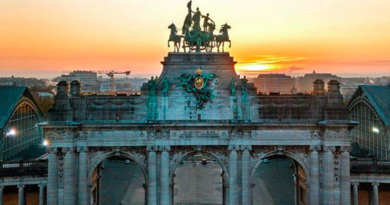They want to kill the Italian Institute of Culture in Brussels
A story of generosity and dedication risks a premature death. Why should you sign the petition?
Belgian “Italophiles”, writers, university lecturers and professors have publicly protested, through petitions published in the main Belgian media, criticising the decision by the Italian state to sell a very important cultural centre in Brussels, while other European countries such as France, Germany and Spain intensify their efforts to maintain their cultural presence in the “capital of Europe” and cherish their splendid cultural centres.
The Spanish “Institut Cervantes” is just one of a series. It is housed in a spectacular townhouse “maison de maître” on the historic Avenue de Tervuren. Spain is not an isolated example: other countries, such as South Korea, have recently opened cultural centres in Brussels which they regard as very important showcases for their cultural achievements. A petition to the Italian Minister of Foreign Affairs Angelino Alfano is now circulating through the social media in Brussels collecting thousands of signatures.
Italy, however, seems determined to write the word “end” to a story which had started over 80 years ago. The Italian Institute of Culture in Bruxelles was created in 1932. Its “cradle” was a 19th century building in Rue de Livourne.
The Italian Ministry of Foreign Affairs, which manages the Institutes of Culture throughout the world, seems determined to transfer the new headquarters of the Italian Institute of Culture and the Italian Consular Office from the present building in Rue de Livourne to an anonymous and colourless building in Rue Joseph II. There is no mention in the announcement of what will happen to the 18,000 books at present in the library of the “Istituto”. The new headquarters are not very spacious and they will certainly not be able to house all these books. The 350 seat theatre where so many Italian plays and films have attracted a cosmopolitan public as well as many Italians living in Brussels will also disappear.
Italians, up until relatively recently were the most numerous group of foreigners living in Belgium, 330.000, excluding the children born in Belgium of Italian parents.
A further reason why so many people have reacted negatively to the news of the sale is due to the fascinating background of the “Istituto di Cultura”, a real historic institution in Brussels.
Exchanges of opinions and ideas had become a feature of the presence of Italian intellectuals in Brussels and several “salons litteraires” created by both Italians and Belgians flourished soon after the birth of Belgium in 1830.
In 1895 the Italian-Belgian Chamber of Commerce was created in Brussels with the increase in economic and trade links between the two countries. The “Istituto di Cultura” was created in 1932 by an Italian woman, Signora Ernestina Cantarella, the wife of an Italian industrialist who had been sent to Brussels by his company. Mrs Cantarella was born in Pavia near Milan.
When she arrived in Brussels she realised that many Italians lived there, since Brussels and indeed the whole of Belgium had historically attracted people who cherished freedom of speech and acted accordingly. The onset of Fascism had driven many Italian intellectuals and workers out of Italy into the arms of “friendly” Belgium.
Mrs Cantarella was surprised to see that the Italian state did not care for the many Italians settled in Belgium, and decided to act by launching a school where the children of Italians in Belgium could learn the language of their parents and retain solid cultural links with their country of origin and where the Belgian Italophiles could also enjoy the resources. Signora Cantarella was not deterred by the difficulties of her project: she started raising funds from Italians living in Belgium and from different Italian companies active in Brussels (the carmaker Fiat, the wine producer Campari, the tyre maker Pirelli, the pasta-maker Barilla etc.). These companies were interested in opening new sales opportunities in Belgium and were sending their employees to work there. People arrived with their families, and the children needed a school where they could also learn or develop their Italian. This is how the Institute, first called “Casa d’Italia”was born. It was the first school for Italian children in Brussels, and Mrs Cantarella herself worked there as a teacher of Italian.
The “Casa d’Italia” became therefore a meeting point for the Italians in Brussels. A theatre was created within the building and a library was started. There were cultural evenings many of them musical and there was an excellent piano on which pianists from Italy or elsewhere could play recitals. It was through this musical side that a niece of Signora Cantarella, Mme Marie-Paule Cantarella, learned to play the piano. She became a talented pianist well known to the Belgo-Italian public. Among some of her cultural initiatives was the organisation of the Ravello Festival in Italy of which she became artistic director. On the occasion of the Festival, Ravello (a splendid historic small city high up on the hills overlooking the beautiful Amalfi coast where she had family links) attracts music lovers from all over the world.
Marie-Paule Cantarella – who had also been a very active organiser of the Belgian “Reine Elisabeth Music Prize ” through the “Chapelle Reine Elisabeth” where the most promising young talents from all over the world come to compete – died prematurely a few years ago.
Ten years after creating the school, Ernestina Cantarella was forced to close it because she refused to accept the “diktat” of the Italian Fascist regime which forced Italian schools abroad to accept the “teachings” of the “Duce” Benito Mussolini. In that period the Italian government refused to recognise the Italian diplomas issued by the Italian School in Brussels which resisted for a while despite threats and direct actions from the Fascist government. Eventually the school closed down and the Fascists seized the “Casa d’Italia” and the Fascist intellectual Giuseppe Bottai (“the most fascist of the fascists”) then governor of Rome took over and the Institute of Culture became “la casa del Fascio”.
The Italian Institute of Culture was downsized and the school offices sent to the top floor while the most prestigious area in the building with decorated rooms became the Italian Consulate. On the first floor the library attracted many students of Italian and many lovers of Italian culture and literature.
The decision taken some years ago by the Italian government to change the status of the Istituto Italiano di Cultura in Brussels so that “famous intellectuals” (in Italian they call them “esperti di chiara fama”) could be sent there instead of capable civil servants with experience in cultural affairs was the last straw in the fragile financial situation of the structure.
Brussels however did not get a “famous intellectual” unlike Lisbon, for example, where the distinguished writer Antonio Tabucchi highly knowledgeable on Portughese culture had been sent to manage the Italian Cultural Institute. Extravagant expenditures piled up which had very little to do with the enhancement of Italian culture but more with the enhancement of a personality cult. Extravagant expenses weakened the finances of the Istituto even further. This costly experiment was then discontinued after a few years and the traditional system of civil servants was reintroduced. But the announcement of the sale has confirmed that the financial health of the Italian Cultural Institute has not recovered in spite of the efforts by some of the previous and subsequent civil servants who headed it. And a diminution of both premises and influence seems inevitable, deeply regretted by all those who love Italian culture.




